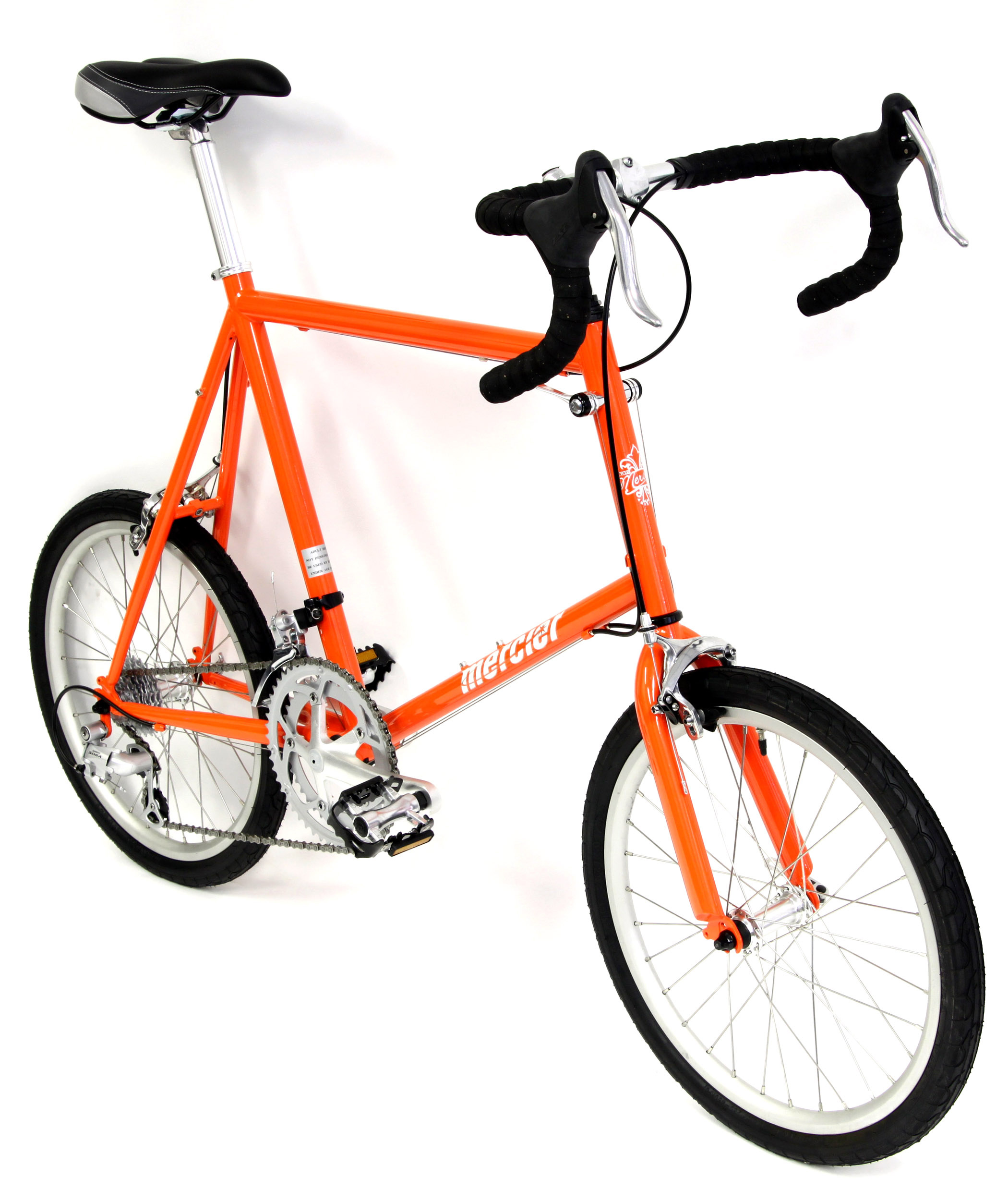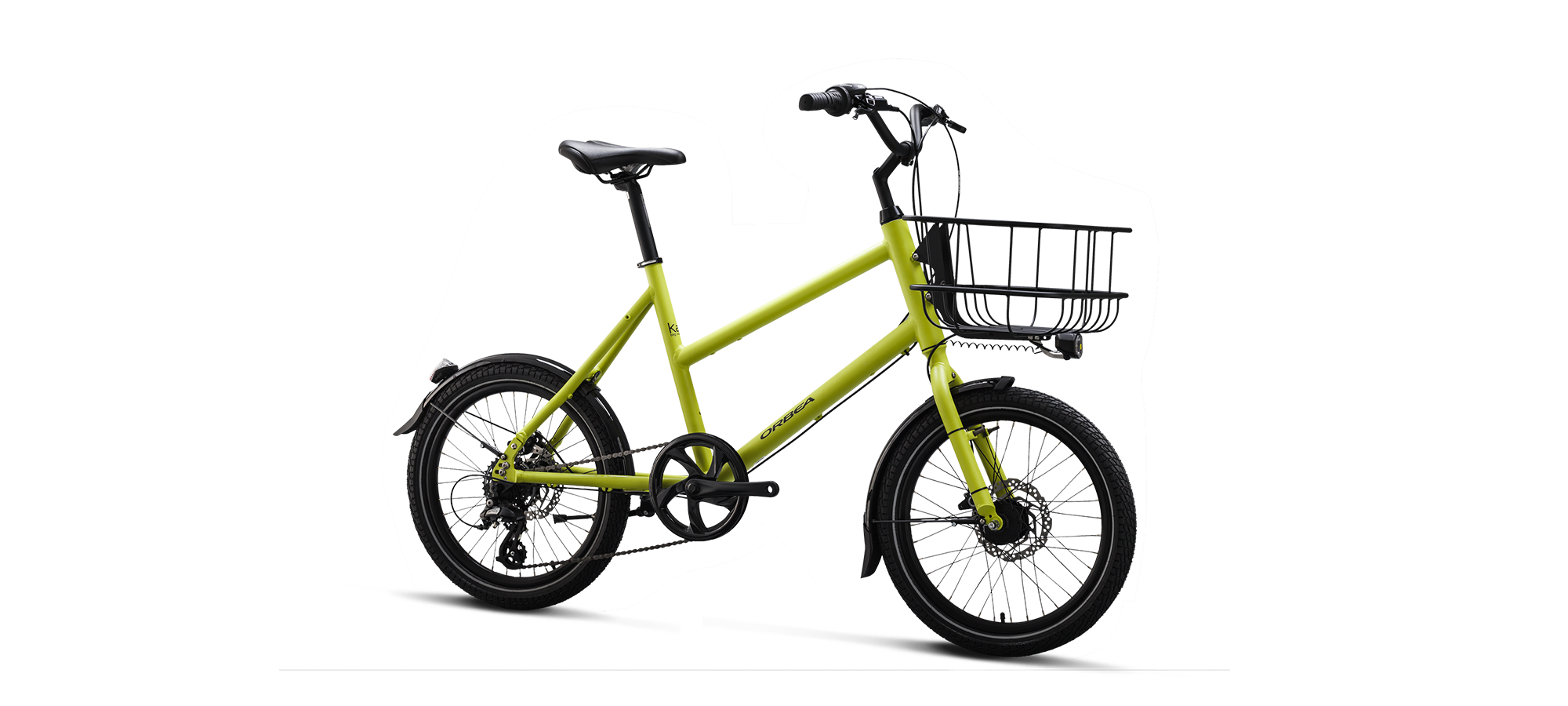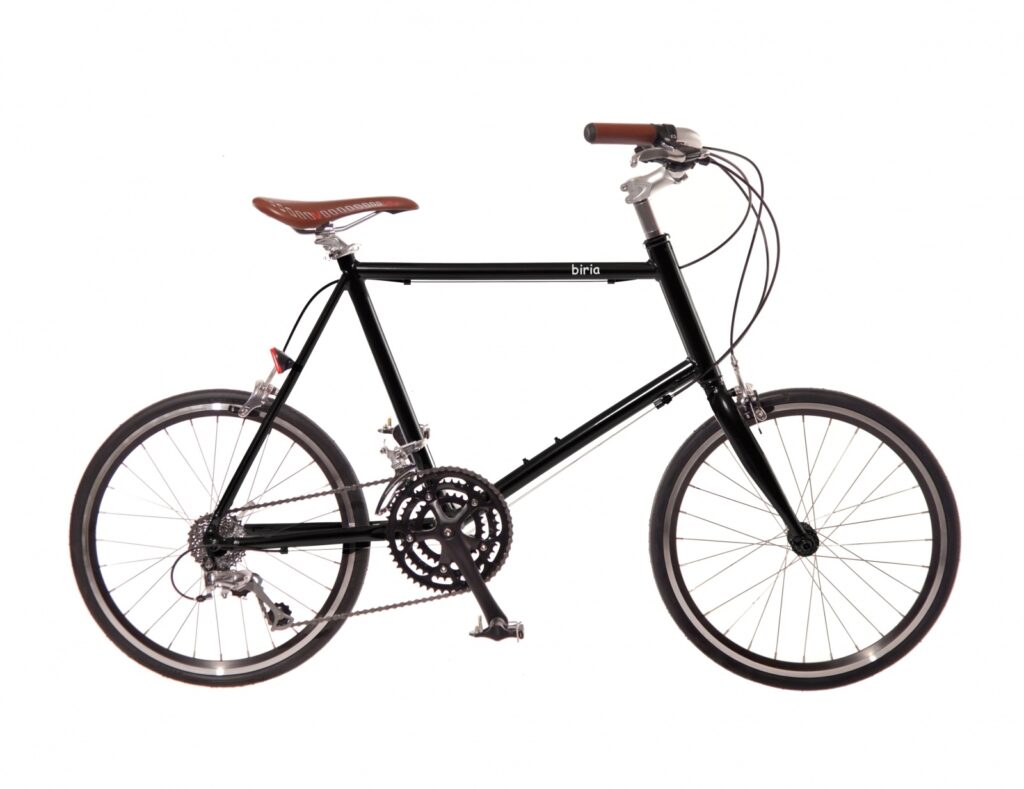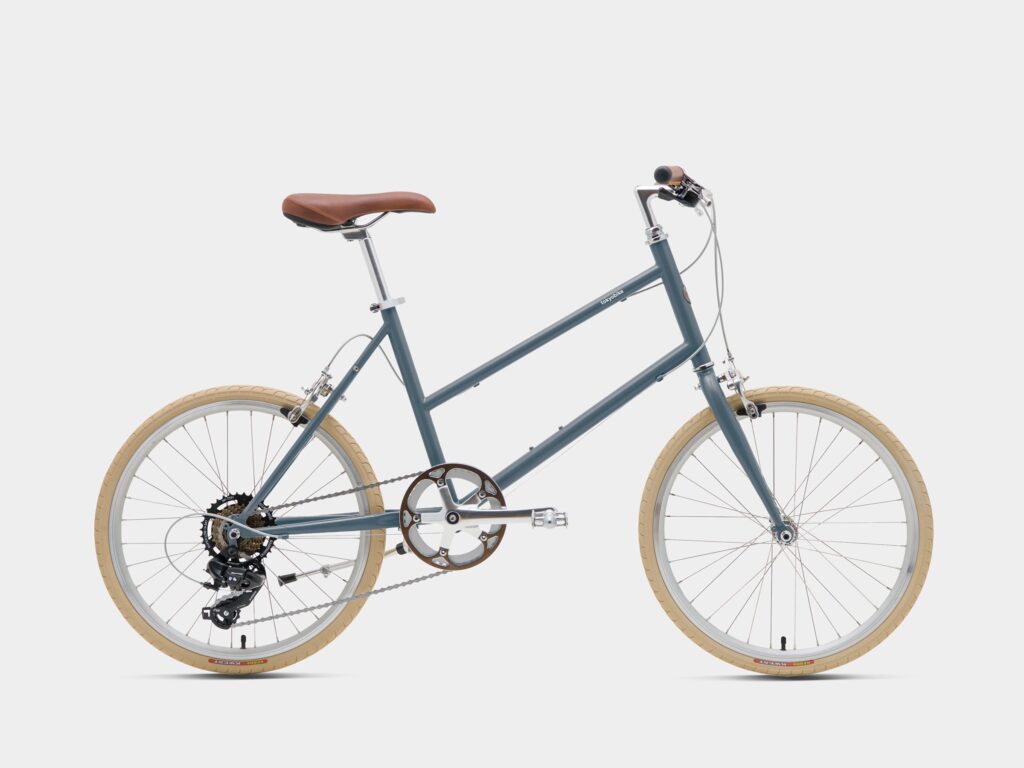Last updated: January 13th, 2024
If you’ve spent much time in large cities, especially in Asia, you’ve probably noticed adults riding surprisingly small-wheeled bikes.
Some have the conspicuous hinges of folding bikes, but others don’t.
The latter is called a mini velo: an adult bicycle with smaller wheels, typically 20″ or less in diameter, but otherwise standard bicycle parts.
Mini velos do not fold at all, since they have rigid frames with no hinges or other movement. They’re popular in dense cities (especially in Asia) where full-size bikes are hard to store or carry, but folding isn’t necessary.
It’s hard to say when mini velos were invented, since small-time inventors no doubt experimented with small-wheeled designs for decades. But they probably first gained popularity with the success of Moulton Bicycle, founded in 1962.
Let’s take a closer look at their design, purpose, and a few brands worth checking out.
This article might contain affiliate links. As a member of programs including Amazon Associates, I earn from qualifying purchases.
A middle ground between full-size & folding
The small wheels of a mini velo make it easier to store in tight quarters and to carry through cramped spaces like stairwells, elevators, and transit facilities.
Small footprint for carrying & storage
A typical mini velo has 20″ wheels. That makes its end-to-end length about 9″ shorter than that of a standard road/city bike with 700c (29″) wheels. Many are even shorter yet, since mini velos usually have a shorter wheelbase (front-to-rear axle distance) than their full-size counterparts.
Their smaller wheels also require less vertical clearance to store. That may not sound like a big deal, but it’s surprisingly helpful when you’re keeping a bike near furniture (such as your desk).
Quick acceleration
Another oft-overlooked advantage is that smaller wheels give snappier acceleration. There’s less mass to get rotating from a dead stop, so the same pedal power gets you moving just a little bit more quickly. It’s not a game-changing difference, but it’s a pleasant surprise in stop-and-go urban riding.
Sturdy wheels (in principle)
Incidentally, smaller wheels are theoretically a bit stiffer and stronger than ones with a wider diameter. After all, less diameter means less side-to-side leverage. This doesn’t always matter in the real world, though, since individual rims and spokes vary in strength, as does wheel build/adjustment quality.
Simpler structure
All the above applies to folding bikes, too. But folding requires clamps and hinges, which mean more weight and fancy engineering to get similar frame strength. Mini velo designers can also take more liberties with geometry, since there’s no need to worry about how the frame will fold down.
Three drawbacks to keep in mind
Small wheels aren’t as smooth
It’s a fact of physics that smaller wheels feel less smooth on a rough surface. As the wheel gets smaller, the cracks and bumps are relatively larger, so they feel more jarring to the rider.
Does that really matter?
Yes and no.
On smoother asphalt, there’s virtually no perceptible difference between smaller and larger wheels (assuming both have the same type and width of tire).
But the differences grow as asphalt gets rougher, or potholes appear, or you venture onto dirt/gravel. There’s no exact threshold beyond which you can’t ride a mini velo. It’s a matter of personal preference. But as a rule, the rougher your ride, the more helpful full-size wheels are.
Traditionally, mini velos have basically the same tire clearance as road bikes. (That’s not much!) But some newer ones can fit wider tires, which offer more cushion and traction to mitigate the rougher ride.
In fact, here is a custom-made example with whopping 2.8″ tires for, well, just about any imaginable terrain. You sure won’t find that at your local bike shop, but it goes to show that small wheels are more capable than you might think.
A shorter wheelbase can feel unsteady
As mentioned earlier, mini velos usually have not only smaller wheels, but also a shorter wheelbase than full-sized bicycles. There are a few exceptions, one of which I’ll highlight toward the end, but this usually holds true.
The shortened wheelbase comes from proportionately reducing both the chainstay length (cranks to rear axle) and front-center length (cranks to front axle), much like on a folding bike.
That’s important for storage and portability, of course, and it also makes the handling feel nimble in tight situations (like on a sidewalk or weaving through traffic).
But just like a kayak can’t plough through waves like a yacht, neither can a mini velo tackle torn-up cobblestones with the surefootedness of a Dutch bike.
Now, that’s not to say it’s a bucking bronco. In fact, the wheelbase of a typical mini velo is in keeping with the wheelbase of a road racing bike. Perfectly reasonable and safe, just not optimal for laid-back cruising over choppy surfaces.
Whether this is a feature or a bug depends on your terrain and riding style. Besides, wheelbase length is just one factor in handling, alongside the head tube angle, handlebar style and position, overall sizing, etc.
But if you want maximum stability from a portable package, you might be better off with a folding bike. For instance, Brompton uses a clever hinge design that allows for a wheelbase like a standard bike yet one of the tiniest folded sizes on the market. It comes at a cost, but most high-end mini velos aren’t cheap, either.
Tires will wear out sooner
Smaller wheels need to spin faster, which leads to faster tire wear. For instance, if a mini-velo wheel is about 7/10 the diameter of a standard one, then it has to roll 10/7 as quickly to sustain the same velocity. That means the tread contacts the ground more frequently and wears down after fewer miles.
You can still expect thousands of miles from a high-quality pair of tires. It’ll be fewer miles than a full-size pair would last, but still enough for at least a year or two of typical urban riding.
This is not a major consideration unless you’re planning a tour or you can’t easily get hold of spares locally.
The 3 main types of mini velos
I’d group mini velos into three categories. These aren’t hard and fast rules, but as of writing, nearly everything on the market falls into one of them.
With each category, I’ll include examples of iconic models from the past or well-regarded ones you can possibly purchase new in 2024.
Availability is usually limited, especially outside Asia, so you may have to forego a test ride.
1. Road-style bikes with drop bars
This first category of mini velo is effectively a road racing or touring bike with shrunken wheels.
You can expect all the distinctive road components: drop handles, brake levers, shifters, fairly narrow tires, and so forth. And just like full-size road bikes, you’ll ride leaning forward in a fairly aggressive position.
The Mercier Nano, from mail-order stalwart Bikes Direct, is a great example of this style:

These are a fun and convenient choice for sport riding, quick dashes around town, and anything else a standard road bike is suitable for.
People do occasionally race them, at least as a bit of a novelty. Here’s an example of one such event from Japan:
2. Hybrid- or city-style bikes with flat bars
Some of the more iconic mini velos, like the Bianchi Merlo made for the Japanese market, are similar to standard hybrid bikes.

That means:
- More or less flat handlebars
- Slightly forward-leaning posture
- Medium-width tires
(Read my breakdown of city versus hybrid bikes for a more thorough explanation of how these things actually impact your ride.)
They’re practical bikes indeed, at the cost of a couple additional pounds over their sportier siblings.
3. Miniature cargo bikes
Cargo mini velos are truly a niche within a niche. So much so, in fact, that there are hardly any to choose from.
The Orbea Katu line exemplifies this style, and we’ll take a closer look at it a bit later.

The large basket and disc brakes are distinctive features at a glance. They’re also a bit longer with more relaxed angles than other mini velos—all for stability, of course.
Five mini velo brands to start your search
The selection of mini velos is narrow. Most bike companies simply don’t offer them.
On the bright side, that makes for a quick selection process!
If I were in the market right now, then these would be my top contenders. This isn’t remotely an exhaustive list, and won’t even wade into the realm of boutique small-wheeled bicycles from brands like Moulton, or any number of custom builders.
All-around use if money’s not an object: Velo Orange Neutrino ($750 frame only / ~$2500+ complete)
Velo Orange might be the coolest bicycle company you’ve (probably) never heard of. You’ll virtually never see them in stores, and even online availability is limited, but they consistently fill gaps that don’t interest larger brands.
And once in a while, they come up with something farther out of the ordinary: to wit, the Neutrino mini velo.
Building from the frame up is always fun, if expensive. But the Neutrino would be a perfect blank canvas, since it comes in three different sizes (most mini velos offer one or at most two), clears massive 2.3″ tires plus fenders, and has sliding dropouts for any possible drivetrain configuration (derailleur, internally-geared hub, or even single speed).
The disc brakes mounts (practically necessary with sliding dropouts) and plentiful rack mounts mean you can build it up for literally anything besides racing or aggressive off-road riding. For a utilitarian cyclist who still likes to have fun on the weekends, there’s no more versatile frame on the market with any wheel size.
The obvious drawback is the price. A Neutrino frame will set you back more than many complete mini velos, and you’ll need to raid the used parts bin to keep the full build under $2000.
That price is hard to justify (I’ve tried!) as a novelty or a new toy, but it’s well within reason for a unique but high-quality frameset that serves a purpose.
Heavy hauling in all weather: Orbea Katu 30 ($799 new, but expect to buy secondhand)
The bad news is Orbea seems to have discontinued their ingenious Katu line as of 2019 or so. The good news is they still pop up on eBay or in bike shops’ clearance sales—at least for now.
If luck is on your side, then you can’t do better for a practical bike in a small package. Better still, the Katu 30 introduced disc hydraulic disc brakes and a dynamo-powered headlight at a steal of a price.
(On the whole, the benefits of disc brakes are exaggerated for everyday use. That said, cargo hauling is one scenario where they’re genuinely worthwhile. And as for dynamo lighting, read this overview to learn more about whether it’s right for your riding.)
This is the one bike in this article that I’ve personally ridden and can recommend firsthand. After all, it’s the only one that was (briefly) sold in large volumes through local bike shops.
So, how was the ride quality? Amazingly…normal. In fact, nothing about the ride quality alone suggested small wheels. The beefy 2.25″ tires undoubtedly played a part in its smoothness. It also has remarkably long chainstays for a mini velo. At 437mm, they’re actually longer than you’d find on a road racing bike.
My favorite feature is the head tube-mounted front basket. In fact, that’s practically necessary for a cargo bike of any size. The issue with generic axle- or fork-mounted baskets and racks is that they noticeably affect how a bicycle handles. At some point around 10 pounds (in my experience), they’ll feel like they resist turning and straightening the handlebars. That’s a huge problem for sharp turns at low speeds.
But when the manufacturer mounts the basket directly onto the frame, then that problem disappears. The basket is stationary relative to the handlebars, so loads of dozens of pounds (or whatever their limit is) have little if any effect on the handling.
If you can’t track down a used or new-old-stock Katu, then keep an eye on eBay for a Cannondale Hooligan. This was an all-too-limited 20″ city bike complete with a head tube basket mount, disc brakes, and the all-around burliness its name suggests.
Your best readily available alternative may be a folding bike, specifically the Tern Verge S8i. However, it’s quite a bit more expensive at $2199, and its head tube-mounted luggage system holds about 15 lbs versus the Katu’s 35 (if memory serves).
While we’re in that price range, the Yasujiro mini cargo bike will set you back a grand for the frame only or $2575 complete. (Fun fact: Yasujiro is a brand of Merry Sales, which is also the parent company of Soma and New Albion. An both of those latter brands sold this same mini velo frame for a short period.)
Denmark’s Velorbis makes an über-traditional model called the Short John, occasionally available through Amazon (surprisingly enough) for a bit under $1900 to your door.
Finally, European customers can buy the rather similar Petit Porteur for a more modest €840.
A more affordable, accessible all-rounder: Biria Mini-20 ($999)
Biria bikes seem far more common Europe than North America, but they offer direct and do have a few dealers dotting the US.
So, as of writing, their Mini-20 is one of the most practical options that North American readers can actually find on somewhat of a budget.

The Mini-20 has a 3×9 Shimano 105 drivetrain, in keeping with road bikes around this price point.
The handlebars have a comfortably swept-back shape, which I strongly recommend for all-around use (as my commuting handlebar overview explains). You can expect a fairly upright riding position, especially if you’re of average height or less.
The 1.125″ (28mm) tires are not unreasonable, but wider ones would’ve helped maximize traction and take the edge off of rough streets.
A budget bike for zipping around town: Tokyobike Mini Velo ($800)
Tokyobike offers a more affordable ways to test the mini-velo waters. They’re sold online and in just a handful of trendy, boutique-style shops around the world.
Their mini velo is built from a chromoly frame and fork, and comes it at a claimed 24.9 lbs. It’s not a featherweight, but is still light enough to carry up stairs without much trouble. This is one of the few models to come in two sizes, with a cut-off around 5’3″.

The quill stem is a wise choice for easy adjustability. The recommend height limit is just 5’9″ on the larger size, so I foresee a lot of folks swapping the stock stem for something taller.
The 1×7 Shimano Tourney drivetrain is disappointing at this price; I’d hope to see at least Claris or Sora, and perhaps a wider-range cassette than the stock 14-28t.
Just like Biria, Tokyobike spec’d 1.125″ (28mm) tires that are adequate, but very much on the narrower side of today’s norms for an urban bike.
Probably the cheapest mini velo: Mercier Nano ($399)
Bikes Direct is the king of direct-to-consumer bike sales, probably in volume and certainly in variety.
And their Mercier Nano, as briefly mentioned earlier, might be the only truly cheap mini velo sold in North America. (There’s no relationship to the Mercier of yesteryear; that storied name is just a trademark these days.)

The 2×8 Shimano Sora drivetrain and chromoly steel frame and fork are pleasant surprises. (At this price point, I’d have expected Tourney and high-tensile steel, respectively.)
However, take note of the stem-mounted friction shifters. Friction shifting isn’t a problem with a little practice, but plan on a few hours in the saddle before it becomes second nature. Moreover, their location on the stem is hard or downright sketchy to reach if you stray onto bumpier terrain.
On the topic of stems, the manufacturer wisely spec’d a quill. It not only streamlines height adjustment, but just feels right with the overall vibe.
The 1.5″ (38 mm) tires are wider than on most drop-bar road bikes. But that’s especially welcome with 20″ wheels, since the extra air volume helps take the edge off bad pavement.
And speaking of (slightly less) retro vibes, here’s a short and charmingly low-res video from 2010 of the Nano in action:
Are there any other options?
If you’re seeking a brand-new bike like the Biria or Tokyobike, but even cheaper, then there are three general options.
The first and easiest is a folding bike. While the folding design has some functional and aesthetic drawbacks, it’s also far easier to find at any price range, but especially lower ones.
The second is to order from a more obscure brand with a decent online reputation. Bikes Direct’s Mercier Nano (also mentioned earlier) comes to mind immediately. I’m not personally familiar and can’t make any firsthand recommendations, but it’s a good option
Finally, keep in mind that mini velos are far more popular in East Asia, particularly Japan, than almost anywhere else. That means some Asian e-commerce sites like Rakuten have an enormous selection. You’ll need to be comfortable reading parts lists and geometry charts, since English-speaking customer service isn’t a given.
Mini velo FAQ
How does mini velo sizing work?
Most mini velos come in one or two sizes, although a few brands (mostly Western ones) offer additional sizes for taller customers.
If two sizes are available, then the threshold between them is typically around 5’7″ or 5’8″, but varies among brands.
One-size-fits-all models typically have extra stem, handlebar, and/or seatpost adjustment to accommodate most adult riders.
Still, tall riders (perhaps 6’2″ and above) may struggle to find one that fits properly. At the very least, some creative stem/handlebar/seatpost options might be necessary to make the bike feel tall and long enough.
Fortunately, those parts are typically standard sizes and not proprietary designs, so they’re easy to swap.
Are mini velos slower than regular bikes?
No, mini velos are not inherently slower than any other type of bicycle. Smaller wheels have to rotate faster to travel at the same speed, so mini velos (like folding bikes) use higher gearing to achieve faster wheel rotation without pedaling faster. With similar effort and posture, you’ll travel the same speed on a mini velo as on anything else.
For a closer look at how gearing relates to wheel size, check out this section of my guide to commuter bike gearing.
However, the wheel size can slow you down slightly on rough terrain. Smaller wheels are less smooth over rough ground, which may slow you down slightly. You can mitigate this effect by using the widest tires your rims and frame will accommodate. Frankly, though, it’s not a serious problem unless you’re racing or riding extensively off-road, neither of which are good uses for mini velos in the first place.
What about mini velos vs. folding bikes?
Mini velos generally have better ride quality and more component options than folding bikes. Get a mini velo if wheel size is your only issue with a regular bicycle. If you need a much smaller package—no more than 26″-36″ in any direction without disassembly—then a folding bike is the only choice.
While a folding bike is obviously more compact to store, its size comes with some tradeoffs. For instance, the folding frame designs adds at least a few ounces of weight, $100-$300 to the price (for comparable parts), and additional points of failure.
Furthermore, bicycle frames traditionally have a triangle shape because it’s a structurally efficient design. It’s both stiff and light at the same time. However, it doesn’t fold down very neatly, so most folding bikes use a single-beam design instead. But mini velos don’t have to fold, so they’re free to use that lightweight, conventional triangular frame.
However, it’s easier to find folding bikes in general. And it’s much easier to find folding bikes with fenders, racks, dynamo lighting, and other city-bike essentials. You can customize most mini velos in a similar fashion, but they almost never include those accessories off the shelf.
A folding bike may also be more practical if you’re not comfortable buying sight-unseen. They’re sold almost everywhere, both new and used.
Conversely, consider a mini velo if availability isn’t a concern, and you want your ride to feel as “normal” as possible in a small package.
Finally, both are good options for airplane travel.
Brompton folding bikes can actually fit in some overhead bins, but nearly all others require disassembly and then go into a checked bag. Mini velos easily disassemble into a checked bag, too, and will feel more “normal” and probably survive rougher terrain at your destination.
Is a mini velo good for commuting?
Mini velos are great for commuting when a) storage is a limitation and b) you don’t have any particular need for a folding frame. Their snappy acceleration is also nice for stop-and-go urban commuting.
As long as it meets most criteria of a good city bike, then odds are it’ll be a great commuter. That said, there’s enough variety of mini velos (and of commutes!) that it’s hard to answer categorically.
For instance, many bike commuters need to carry a bicycle up and down tight staircases at home or at the office. In that situation, full-sized wheels are cumbersome to manage and can obstruct other people. It’s also easier to get oneself dirty by brushing against them.
Mini velos are easier to handle in that scenario, and can often be stored at your desk or in a closet where conventional bicycles don’t fit.
How do mini velos vs. road bikes compare?
Both are great choices for urban riding, and can be set up as fast- and aggressive-feeling as you like.
Mini velos with drop bars have similar posture to a road bike. All else being equal, the mini velo may feel snappier and more agile, whereas the road bike will feel smoother, especially at high speed.
It’s a fairly subtle difference, so don’t choose on that basis alone.
Drivetrain components are usually the same, although mini velos have higher gear ratios to offset the smaller wheel diameter. The result is similar gear-inches (here’s a good calculator) and therefore similar speed at a given pedaling cadence.
Identical brakes may feel slightly more powerful on full-size road bikes than on mini velos. Just like a larger rotor makes disc brakes more powerful, a larger rim makes rim brakes more powerful. However, it’s a very subtle effect in my experience, and it’s hard to isolate from other variables, like pad alignment and cable tension.
The biggest difference is availability for tall riders. Road bikes are readily available in large sizes. Mini velos are less common to begin with; only some are built in a road bike style (with drop bars), and only some of those are suitable for tall folks.
